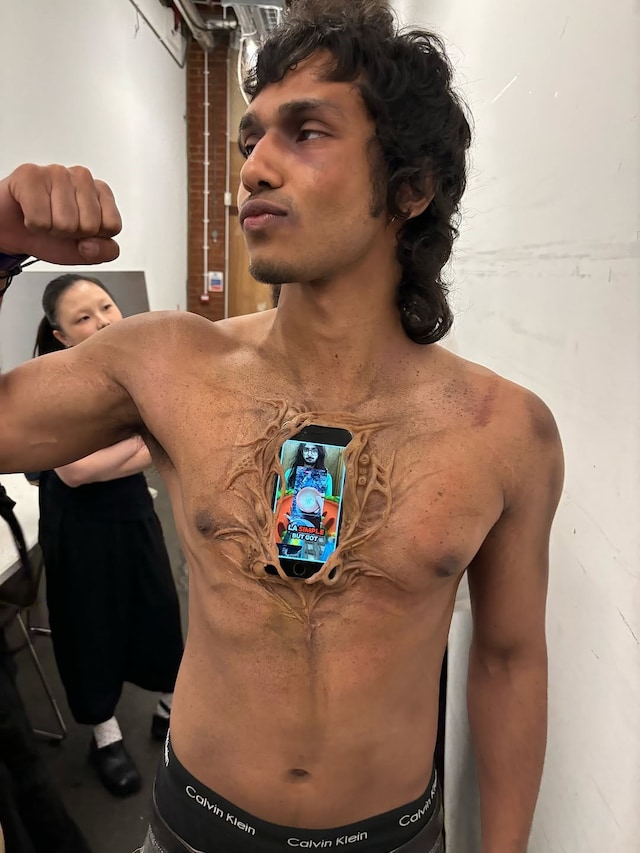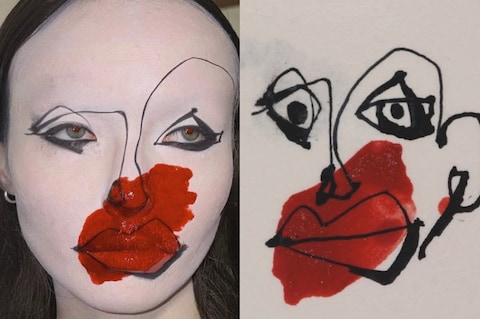 Courtesy of Kai GhattauraNovember
28,
2025BeautyFeatureHow tech-inspired SFX is revealing our anxieties about a cybernetic future
Courtesy of Kai GhattauraNovember
28,
2025BeautyFeatureHow tech-inspired SFX is revealing our anxieties about a cybernetic futureAs the overlap between tech and the body accelerates, our fears of an increasingly digital future are starting to surface on the runway
ShareLink copied ✔️November 28, 2025BeautyFeatureTextTiarnaRead More FashionThis is the only England shirt you need for next year’s World Cup
FashionThis is the only England shirt you need for next year’s World Cup Art & PhotographyDerek Ridgers’ portraits of passionate moments in public
Art & PhotographyDerek Ridgers’ portraits of passionate moments in public MusicThe house party isn’t dead, according to a new report
MusicThe house party isn’t dead, according to a new report
AI boyfriends, iPad babies, and Sabrina Carpenter Fortnite skins: everywhere you look, the boundaries between technology and the human body are fraying. As we plug in, log on, and upload, our physical selves feel increasingly secondary to the digital versions we present online. This fear of bodily displacement is now being expressed in SFX, a medium long used to dramatise anxieties through the contortions of the human form. But today, it reflects a near-future reality: the absorption of technology into the human body, and the creation of a cybernetic future.
In the latest runways we are seeing the emergence of tech-based SFX make-up entangled with the human form. Throughout designer Rohan Mirza’s runways, we see gaming accolades and technology embedded into SFX skin: think Call of Duty medals thick under the skin, wrists strapped with skin-deep watches, and headphones around necks plugged into the pits of stomachs. Mirza has attributed this fascination with tech to an upbringing on the internet, surfing between creepypastas, video games, and down rabbit holes. Created by SFX artist Loïse Hulin, the designs are part of her larger SFX world, which she describes as “a continuum of horrific visions between the gory and the touching, the gory and the fantastic.”
Designer Kai Ghattaura’s runway looks also veer into tech-meets-human bodyplay. His recent show, A Scattered Dream, included a pink Lost Mary tangled between sinewy SFX skin, as well as a glowing iPhone embedded into a torn chest, streaming sloppy brain-rot to the crowd. Like Mirza, he was also inspired by his terminally-online upbringing, spent between sites like 4chan, Reddit and fashion forums in his youth. It is a union between our bodies and tech that the team and SFX artist Echo Seireeni set out to achieve: “We had several discussions about the phone and vape as metaphysical prosthetic extensions for Gen Z, and so we went for a pretty literal representation of these kinds of ideas,” Seireeni tells us.
SFX make-up has always been a medium for expressing societal horrors, as it allows a visual embodiment of the anxieties that haunt us on a larger level. Films full of mauled faces with rotting pits of crumbling flesh are used to embody our fears of decay and death; oozing boils signal fear of infection and contamination; bug-eyed silver aliens reflect our terror of the extraterrestrial. It is a Cronenbergian form of SFX that has often focused on the destruction of the human form, and the welcoming of something more sinister, as seen with the revival of women-focused body horror movies, where SFX was used to explore the most distressing facets of the female experience.
The humanification of technology is the same one that has welcomed AI companions like Alexa and Siri into our social circles and AI chatbots as our personal confidants. These sorts of technologies have given rise to the term the ’Internet of Bodies’, used to describe a network of human bodies connected to the internet using devices that are worn, implanted, or ingested to monitor and/or alter bodily functions. The idea suggests that our physical bodies are becoming less central to identity, which is increasingly defined in digital spaces – an idea that is reflected back to us in the cybernetic iterations we see in the SFX world.
This idea is expressed in these runway examples, where the tech embedded in the body could also be a reflection of the metrics we use to measure social worth. Whether that’s gaming achievements, like Call of Duty stats or Fortnite Victory Royales, digital skills such as Blender proficiency, or material markers, like luxury watches. In today’s world, our presence in online spaces is increasingly defining our real-world value. And as these metrics become so essential to our identities, they literally become part of us.
This tech-body marriage also exposes something darker about the body’s place in the post-digital age. With biohacking, Neuralink implants, and the integration of AI into our functioning, the merging of technology and flesh feels increasingly inevitable. SFX, long used to express our deepest social fears, now portrays a near-future reality: the human form is no longer the centre of identity, and its boundaries are increasingly defined by digital and technological extensions. In this way, SFX is not just expressing our fears, it’s peeling back the skin to offer a glimpse of what could come.
ShareLink copied ✔️More on these topicsBeautyFeatureprostheticsmake upTechnologyExpand your creative community and connect with 15,000 creatives from around the world.
READ MORE

Bleach play: How halo rings and ghost roots are taking over hair trends

Echo Seireeni’s prosthetic creations are warping reality

My year of divesting from beauty culture

Can psychedelics enhance your workout?

So you want to smell like an ancient god?

Inside India’s blossoming drag scene

Dina, the Siberian make-up artist transforming into works of art

The sinister rise of the ‘skinny BBL’

Starface wants us to have a Charlie Brown Christmas

What it’s like to be called ‘old’ as a 20-something online

Nicola Formichetti on MAC Cosmetics’ new ‘indie’ era

